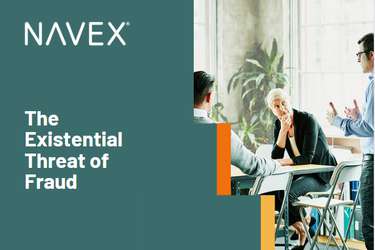Read part 1: Why People Engage in White-Collar Crime
Any conversation around white-collar crime, needs to drill down into motivations. What drives people – who are often seen as exemplary in many other ways – to commit criminal acts. That is what we will focus on here in part two of our white-collar crime series.
Eugene Soltes, a Harvard professor, has provided us with a few insights in his book “Why They Do It.” Soltes directs our attention to the perpetrators of such crimes. His work is based heavily on actual interviews that he conducted with white-collar criminals currently serving their sentences.
Traditionally, white-collar crime has been blamed on the lack of self-control, deviant behaviour, the “bad apple” concept, pathological characteristics, brain chemistry, psychopathy and even peer pressure.
A lot of these theories have been discredited while others have revealed very little. So, Soltes decided that he would hear it directly from the horse’s mouth.
In his interviews, one common response that he always received was that the perpetrator never stopped to think of the consequences. These executives-turned-criminals didn’t even consider the possibility that what they were engaging in, at the time, could be a crime. In other words, there was no self-reflection on their part.
Soltes goes further into the rabbit hole and explores the very psychology behind decision making. What he suggests is something that fits in perfectly with Buell’s ideas. In modern corporations and organisations, the leader has very little exposure to the customer, shareholder, or even the general public.
Read More: Compliance Training Makes the Slope a Little Less Slippery
This metaphorical distance prevents the decision-makers from seeing what their decisions can do.
This metaphorical distance prevents the decision-makers from seeing what their decisions can do. They see their actions as being unremarkable and even necessary, thereby, unwittingly failing to acknowledge the possible disasters that could occur as a result. In other words, there are no moral and ethical filters being used.
So, how do we solve the problem?
Over the years, organizations and regulators have toiled hard to put in place a solution that steers organizations to an ethical path of doing business. Let's review some potential solutions that have been in place from the country level down to an individual level.
Regulators are incentivizing whistleblowers to report externally. More and more mechanisms are available for whistleblowers to notify regulators and trigger investigations. The biggest testament is a qui tam lawsuit, which empowers whistleblowers to file suit directly against an organization under the False Claims Act. The whistleblower is incentivized with a monetary reward similarly as if the suit was pursued privately, but without the legal fees. On the other hand, the Dodd-Frank Wall Street Reform and Consumer Protection Act provides another safeguard by incentivizing whistleblowers in the financial world. These incentives increase the government’s ability to prove the existence of fraud and help in the recovery of lost funds.
Read More: The New Voice of The Whistleblower
Similarly, the SEC and DOJ have imposed large penalties on organizations in the range of millions of dollars to reprimand unethical activities. Besides civil and criminal penalties, other actions exist that allow the government to penalize an organization (aka the contractor) by excluding them from future contracts, suffocating their business to a slow death, on the evidence that the officers or managing employees knew or “should have known” about the wrongful conduct. Furthermore, the memo from Sally Yates has pierced the corporate vale by going after individuals, especially the C-suite. As an example, refer to People v. Guiamelon, (2012) where a conviction under state healthcare anti-kickback law penalized a physician, rather than sanctioning the organization.
The mechanisms placed into society has involved solutions provided by Soltes and Buell. Soltes suggests preventive measures such as appointing people who have the authority to question top-level executives. When executives have their decisions questioned by a larger group of people, the chances of them acting selfishly or shortsightedly are likely to be much lower.
The most important thing to do is to redefine corruption.
Buell, on the other hand, suggests more transparency, stricter regulations and even incentivized “good behavior.” However, he says, the most important thing to do is to redefine corruption. From this point, we dive into the fact that organizations play a role in operating above the law. Laws should be perceived as a minimum baseline by which societies are required to function – not the maximum.
Organizations have been directed to implement a compliance program, in line with U.S. Federal Sentencing Guidelines §8B2.1(a)(2) to “encourage ethical conduct and a commitment to compliance with the law.” Organizations who feel responsible toward their customers develop such a program voluntarily.
Some examples come to mind where guidance from the compliance program should drive business decisions to help nurture a culture of compliance:
- For the love of the law. With organizations being penalized and new case law bring formed lately, all organizations need to be wary of their outcomes.
- Compliance as a part of the strategy / Culture of Compliance. True values are demonstrated when the C-suite and board realize that a business decision cannot be based on wild west actions but instead need to reinforce their compliance program standards. Simply put, involve the compliance officer in strategy meetings.
- Reputation as a function of ethics. Reputation is not an output of profit and revenue but rather an equal function of the organization's ethical culture. There are companies that speak to the fact that ethics and compliance matters – such as “Tata” which took over Landrover and Jaguar, Lilly the pharmaceutical, GE and other companies on the list of World's Most Ethical Companies.
- Yearly appraisal. Integrate ethics and compliance as a part of an organization's annual appraisal, whether it may be a promotion or merely an annual evaluation.
- Incentivizing ethical behavior. This point is a debatable one, but I will still put it out there since some schools of thought believe that ethics should be expected and therefore should not be incentivized. So, organizations should set out incentives for people who try to stand out from others for the betterment of ethics and to penalize the rogue employees even though he/she might be the best sales performer under tremendous pressure to bring in business.
- Safeguarding employees against retaliation. A culture of fear can railroad a culture of compliance. Being an investigator, I understand that everything requires evidence. Thus, an internal reporting mechanism needs to be put in place to safeguards employees from retaliation. Management oversight and tone and the top are two significant factors that can help curb retaliation.
- Sharing values with third parties / agents. The "respondent superior doctrine," which implies “let the master answer” is a doctrine that states a party is responsible (civil and criminal) for acts of their agents as witnessed in the New York Central & Hudson River Railroad Company v. the U.S.A. This doctrine at its core states that organizations are liable for the acts of their agents even if they are not authorized. Thus it is imperative that thorough third-party risk due diligence is performed before you take employees or agents onboard. At no stage does it mean that the agents can go scot-free, but that they would be held equally responsible and to a lesser degree than the master hiring them as witnessed in US v. Reis.
- Communication and transparency. Creating an environment of secrecy can lead to a culture of risk and thus unethical acts and potential white-collar crimes.
- Retaining and respecting leaving employees. Exit interviews can provide honest feedback on brewing misconduct and toxic environments within the business. They, therefore, should be taken very seriously and should act as an input to the monitoring plan. This will give a lot of visibility to the prevailing conditions.
Key Takeaways
- White collar criminals thrive on opportunity available in the corporate world; the business pressure created due to rising demands to get good numbers in a balance sheet and rationalization giving the corporate criminal that this is the culture itself and thus it is normal.
- Organizations need to net the culture of compliance into the organizational strategy and decision making.
- Organizations need to create more data points to combat the culture of fear which is brewed by the intoxicating environment.
- Even though a large portion of fraudsters are employees, it can be challenging to implement fair policies that target such individuals.
- Society and culture outside office play a significant role in shaping peoples personality and thus background checks, and due diligence plays a vital role in identifying white-collar criminals.









